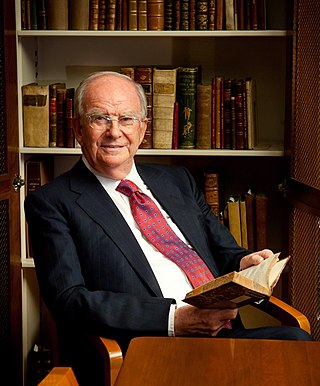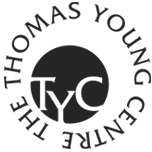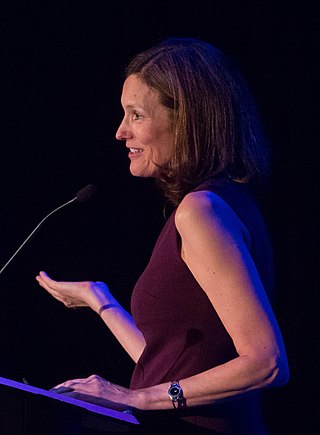Related Research Articles
Montclair State University (MSU) is a public research university in Montclair, New Jersey, with parts of the campus extending into Clifton and into Little Falls. As of fall 2018, Montclair State was, by enrollment, the second largest public university in New Jersey. As of November 2021, there were 21,005 total enrolled students: 16,374 undergraduate students and 4,631 graduate students. It is classified among "R2: Doctoral Universities – High research activity". The campus covers approximately 252 acres (1.02 km2). The university offers more than 300 majors, minors, and concentrations.
Helmut Ringsdorf was a German polymer chemist. His work promoted cross-disciplinary discussions and collaborations in the field of polymer chemistry, biology, physics and medicine.

Sir John Meurig Thomas, also known as JMT, was a Welsh scientist, educator, university administrator, and historian of science primarily known for his work on heterogeneous catalysis, solid-state chemistry, and surface and materials science.

Michael Stanley Whittingham is a British-American chemist. He is a professor of chemistry and director of both the Institute for Materials Research and the Materials Science and Engineering program at Binghamton University, State University of New York. He also serves as director of the Northeastern Center for Chemical Energy Storage (NECCES) of the U.S. Department of Energy at Binghamton. He was awarded the Nobel Prize in Chemistry in 2019 alongside Akira Yoshino and John B. Goodenough.
William James Feast is a British chemical scientist and academic.

The Thomas Young Centre (TYC) is an alliance of London research groups working on the theory and simulation of materials (TSM). It is named after the celebrated scientist and polymath Thomas Young (1773–1829), who lived and worked in London and is known in the world of science for a number of important discoveries concerning the wave nature of light, the theory of vision, the elastic properties of solids, and the theory of surface tension. The participating research groups are based mainly at Imperial College London, King's College London, Queen Mary University of London (QMUL) and University College London (UCL), but there are also members at the National Physical Laboratory in Teddington. The aims of the TYC are to foster collaboration between TSM research groups in London, to provide a world-class source of graduate education in the field, and to address problems of major importance to industry and society. The current (2009) membership of TYC numbers about 80 research groups, of which six are led by Fellows of the Royal Society.

Egbert (Bert) Willem Meijer is a Dutch organic chemist, known for his work in the fields of supramolecular chemistry, materials chemistry and polymer chemistry. Meijer, who is distinguished professor of Molecular Sciences at Eindhoven University of Technology (TU/e) and Academy Professor of the Royal Netherlands Academy of Arts and Sciences, is considered one of the founders of the field of supramolecular polymer chemistry. Meijer is a prolific author, sought-after academic lecturer and recipient of multiple awards in the fields of organic and polymer chemistry.
Joan B. Berkowitz was an American chemist. Her areas of research have included materials for the space program, reusable molds for spacecraft construction built from molybdenum disilicides and tungsten disilicides, and the disposal and treatment of hazardous wastes. She was the first woman to serve as president of The Electrochemical Society.
Dipankar Das Sarma, popularly known as D.D. Sarma, is an Indian scientist and structural chemist, known for his researches in the fields of Solid State Chemistry, Spectroscopy, Condensed Matter Physics, Materials Science, and Nanoscience. He is a former MLS Chair Professor of Physics and Chairman of the Centre for Advanced Materials and the GAST Professor of Uppsala University, Sweden, A recipient of TWAS Physics Prize and the UNESCO Biennial Javed Husain Prize, Sarma was honored by the Council for Scientific and Industrial Research (CSIR), Government of India, in 1994, with the Shanti Swarup Bhatnagar Prize for Science and Technology.
Catherine T. Hunt is an American chemist. In 2007, she served as the president of the American Chemical Society (ACS). She was a director at Dow Chemical Company.

Nancy Beth Jackson was an American chemist. She did energy research on heterogeneous catalysis and the development of alternative fuels. She also worked in the field of chemical nonproliferation, educating chemical professionals on the importance of safe and secure chemical practice in research, teaching and business, in an effort to prevent the misuse of chemicals as "weapons, poisons, explosives or environmental pollutants". She was the first implementer in developing the international Chemical Security Engagement Program. She was active in promoting diversity in STEM fields. She was president of the American Chemical Society in 2011, leading the organization during the International Year of Chemistry. In 2012, she was honored with the AAAS Award for Science Diplomacy.

Stephen J. Mackwell is a researcher in geophysics, specializing in laboratory-based studies of the physical, chemical and mechanical properties of geological materials. He is also interested in the transport of fluid components in mantle and crustal rocks on the microscopic and macroscopic scales, and on the effects of such components on mechanical properties. He has authored or co-authored over 80 articles in international scientific journals and is an editor of a book on comparative climatology of terrestrial planets published by the University of Arizona Press.
Kalya Jagannath Rao, popularly known as K. J. Rao, is an Indian physical chemist and an Emeritus professor at the Indian Institute of Science. He is known for his researches on nanomaterials, amorphous Materials and ceramics and is an elected fellow of the Indian National Science Academy, National Academy of Sciences, India, International Academy of Ceramics, Asia Pacific Academy of Materials and World Innovation Foundation and the Indian Academy of Sciences. The Council of Scientific and Industrial Research, the apex agency of the Government of India for scientific research, awarded him the Shanti Swarup Bhatnagar Prize for Science and Technology, one of the highest Indian science awards, in 1984, for his contributions to chemical sciences. He is also a recipient of the Ordre des Palmes Académiques of the Government of France.
Boyapati Manoranjan Choudary is an Indian inorganic chemist and a former senior scientist at Indian Institute of Chemical Technology. He is known for his studies on Nanomaterials to Nanomedicine and is an elected fellow of the Indian National Science Academy, and the Indian Academy of Sciences. The Council of Scientific and Industrial Research, the apex agency of the Government of India for scientific research, awarded him the Shanti Swarup Bhatnagar Prize for Science and Technology, one of the highest Indian science awards, in 1990, for his contributions to chemical sciences.

Ann E. Weber is the senior vice president for drug discovery at Kallyope Inc. in New York City. She previously worked with Merck Research Laboratories (MRL), joining the company in 1987 and retiring from the position of vice president for lead optimization chemistry in 2015. She has helped develop more than 40 drug candidates including FDA-approved treatments for Type 2 diabetes. She has received a number of awards, including the Perkin Medal (2017) and has been inducted into the ACS Division of Medicinal Chemistry’s MEDI Hall of Fame.

Sylvia Marie Stoesser, was an American chemist. She was the first woman to be employed as a chemist at Dow Chemical Company. During her time at Dow, she made a number of major contributions, holding more than two dozen patents as a result of her research.
The Sylvia M. Stoesser Lecture series was established in 2000 by the Department of Chemistry at the University of Illinois. It is supported by alumna Yulan Tong and by Dow AgroSciences. It is named after the first woman chemist to work at Dow, Sylvia M. Stoesser. The lectureship is given every two years to "an individual who has made outstanding contributions to the chemical community and provides new perspectives in the chemical field outside academia."
Anthony Roy West FRSE, FRSC, FInstP, FIMMM is a British chemist and materials scientist, and Professor of Electroceramics and Solid State Chemistry at the Department of Materials Science and Engineering at the University of Sheffield.
Valerie J. Kuck is an American chemist. She is a Fellow of the American Chemical Society, and she was awarded the Garvan–Olin Medal in 2018 "for pioneering research on coatings for optical fibers and copper wire and for transformative achievements leading to a more diverse and inclusive chemical profession". Madeleine Jacobs, President of the Council of Scientific Society, commented on Kuck's reception of the award that "Valerie’s research led to 25 patents and 26 technical publications published in top peer-reviewed journals. [Her] service to chemistry and to the American Chemical Society is almost without peer".
References
- ↑ "Lynn Schneemeyer".
- ↑ "Sylvia M. Stoesser Lecturer 2003-04 - Lynn Schneemeyer". University of Illinois at Urbana-Champaign. Retrieved 27 June 2019.